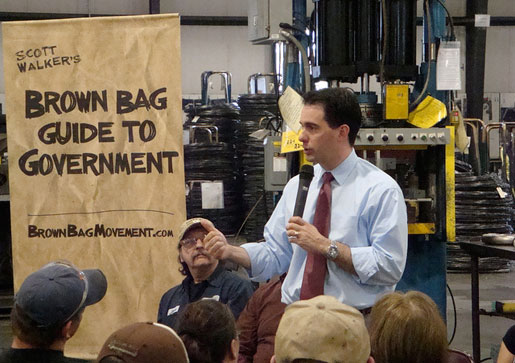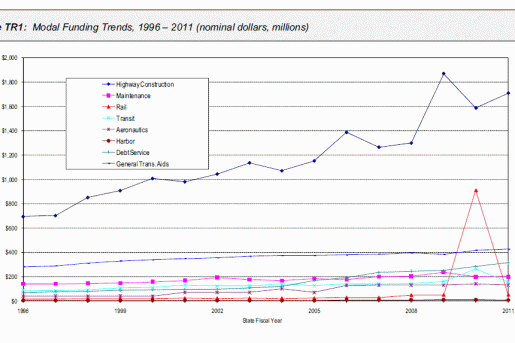
Scott Walker ran for governor with a no-train message. Photo: Scott Walker for Governor
In hard economic times, it’s difficult to believe that two states are together rejecting more than a billion dollars in federal money. Ohio and Wisconsin will not undertake high-speed rail projects that were in development as late as last November. New leadership in both states claimed the rail projects would forever burden their state budgets. In the morning light, however, their objections may face fresh scrutiny.
Last July, President Obama’s Transportation Secretary, Ray LaHood, stopped in Wisconsin touring the country with a plan he said was only rivaled by President Eisenhower’s interstate-highway system. “High-speed rail is coming to Wisconsin,” LaHood said. “There’s no stopping it!”
 Scott Walker, the Milwaukee County executive and Republican candidate for governor, didn’t agree. Walker became the “No Train” candidate as he campaigned across the state before Election Day in November. He put up a website, www.notrain.com. And, he had words for Washington: “It’s outrageous for Secretary La Hood to suggest that your administration can force Wisconsin to continue building a train it doesn’t want and cannot afford,” Walker wrote in a letter to the president. “Almost as outrageous as the fact that the decision to saddle Wisconsin taxpayers with untold millions in operating and maintenance costs, forever, was never debated or voted on by the Wisconsin legislature.”
Scott Walker, the Milwaukee County executive and Republican candidate for governor, didn’t agree. Walker became the “No Train” candidate as he campaigned across the state before Election Day in November. He put up a website, www.notrain.com. And, he had words for Washington: “It’s outrageous for Secretary La Hood to suggest that your administration can force Wisconsin to continue building a train it doesn’t want and cannot afford,” Walker wrote in a letter to the president. “Almost as outrageous as the fact that the decision to saddle Wisconsin taxpayers with untold millions in operating and maintenance costs, forever, was never debated or voted on by the Wisconsin legislature.”
Walker promised to turn down $810 million in stimulus dollars for a completely federally funded train line from Milwaukee to Madison that would eventually connect Chicago and Minneapolis-St. Paul.
Walker went on to win the election with 54 percent of the vote; the first Republican governor in Wisconsin in eight years.
While his opponent argued throughout the campaign that the state would lose thousands of jobs without the multimillion dollar project, Walker said the money should be used for highways instead. “More than 60 years ago, the federal government had the foresight to recognize that the American people no longer wanted to be limited by fixed-track passenger rail,” he wrote in a second letter to Washington, this time to LaHood. “The massive investment in our federal interstate highway system spurred the greatest economic expansion in our nation’s history. For us to now go backwards on transportation makes little sense. I believe that continuing responsible investments in our road infrastructure is a key to growing our economy and creating jobs.”
LaHood wasn’t buying it. Plus, the money could only be used for high-speed rail. The transportation secretary took back nearly all the $810 million before the newly elected governor could even return the check. In Ohio, new Gov. John Kasich, a Republican, also ran against high-speed rail in favor of roads and bridges. Like in Wisconsin, the Obama administration, again, took back the money.
Contrary to what people think, roadwork isn’t inexpensive. Governors Walker and Kasich won, in part, talking only about the great expense of high-speed rail in contrast to the practicality of highway maintenance. USPIRG (the federation of state public interest groups), however, has a study that puts the cost of roads and bridges in perspective. For starters, the tax on what you pay at the pump doesn’t begin to cover the cost of the country’s transportation system. According to the report, “Since 1947, the amount of money spent on highways, roads and streets has exceeded the amount raised through gasoline taxes and other so-called ‘user fees’ by $600 billion.”
Deficit spending and borrowed tax dollars from the country’s general fund have made up the difference.
In Wisconsin, the state projected high-speed rail operating costs at $16.5 million a year. After fare and concession revenue, the taxpayers would be on the hook for about $7.5 million. Gov. Walker said the state could not pay the added money to keep the trains running year after year. But, a new estimate dropped the state obligation below $5 million. And of that money, the feds could pick up anywhere from 80 to 90 percent of the cost. Compare that to the cost of an average road construction project in northeast or southeast Wisconsin last year: While some are in the hundreds of thousands of dollars, the majority are in the millions and well exceed whatever it would cost to maintain the Milwaukee-to-Madison line for a year.
The Wisconsin Department of Transportation does, in fact, project a $300 million budget shortfall over the next two years. Walker is right to worry. But it is a road and bridge problem – not a rail problem. Take a look at the chart below:





*The 2010 and 2011 amounts are budgeted figures. Credit: Wisconsin Department of Transportation
Even after Wisconsin stopped increasing the state gas tax in 2005, highway spending (blue line) has still increased and remained in the billions annually. Take note of the red line for state rail funding, though. In 2010, it jumps over $800 million. In 2011, as promised by Walker, it takes a considerable dive.


